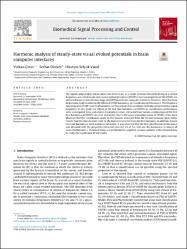| dc.contributor.author | Çetin, Volkan | en_US |
| dc.contributor.author | Özekes, Serhat | en_US |
| dc.contributor.author | Varol, Hüseyin Selçuk | en_US |
| dc.date.accessioned | 2020-08-17T10:07:33Z | |
| dc.date.available | 2020-08-17T10:07:33Z | |
| dc.date.issued | 2020 | en_US |
| dc.identifier.citation | Cetin, V., Ozekes, S., & Varol, H. S. (2020). Harmonic analysis of steady-state visual evoked potentials in brain computer interfaces. Biomedical Signal Processing and Control, 60, 6. doi:10.1016/j.bspc.2020.101999 | en_US |
| dc.identifier.issn | 1746-8094 | |
| dc.identifier.issn | 1746-8108 | |
| dc.identifier.uri | https://hdl.handle.net/20.500.12294/2499 | |
| dc.description.abstract | The signals generated in the occipital lobe of the brain, as a result of visual stimuli flickering at a certain frequency, are called steady-state visual evoked potentials (SSVEPs). Spectral properties of the SSVEPs are extracted to use in classification stage in SSVEP based brain-computer interfaces. However, there has been no previous study examining the effects of SSVEP harmonics on classification performance. The frequency spectrum of an SSVEP consists of harmonics at frequencies that are integer multiples of the stimulus signal frequency. In this study, the effects of the first four harmonics of SSVEPs in classification performance were investigated. Total and relative band power values, extracted from various combinations of the first four harmonics of SSVEPs, are used as features. Due to the quasi-sinusoidal nature of SSVEPs, it has been observed that the classification made by the features extracted from the second harmonic gives better results than the classification made by the features extracted from the first harmonic. In addition, if more than one harmonic is used in feature extraction, it was observed that the best classification performance was obtained with the properties extracted from the set of 1st, 2nd and 4th harmonics, in almost all cases. Furthermore a statistical study was performed by applying variance analysis to the obtained data to verify the significance of the results. | en_US |
| dc.language.iso | eng | en_US |
| dc.publisher | Elsevier | en_US |
| dc.relation.ispartof | Biomedical Signal Processing and Control | en_US |
| dc.identifier.doi | 10.1016/j.bspc.2020.101999 | en_US |
| dc.identifier.doi | 10.1016/j.bspc.2020.101999 | |
| dc.rights | info:eu-repo/semantics/closedAccess | en_US |
| dc.subject | Brain-Computer Interface | en_US |
| dc.subject | Steady-State Visual Evoked Potentials | en_US |
| dc.subject | Harmonic Analysis | en_US |
| dc.subject | Feature Extraction | en_US |
| dc.title | Harmonic analysis of steady-state visual evoked potentials in brain computer interfaces | en_US |
| dc.type | article | en_US |
| dc.department | Mühendislik ve Mimarlık Fakültesi, Bilgisayar Mühendisliği Bölümü | en_US |
| dc.identifier.volume | 60 | en_US |
| dc.identifier.startpage | 1 | en_US |
| dc.identifier.endpage | 6 | en_US |
| dc.relation.publicationcategory | Makale - Uluslararası Hakemli Dergi - Kurum Öğretim Elemanı | en_US |


















